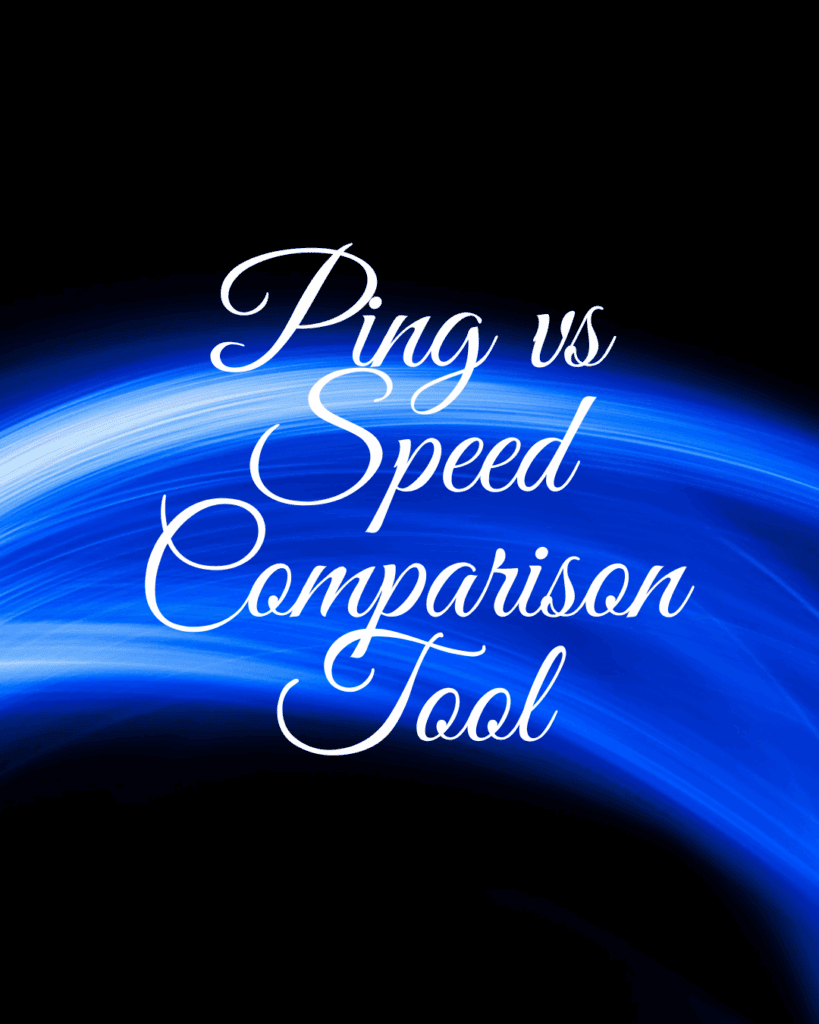📶 Ping vs Speed Comparison Tool
| Metric | Value | Impact Score (0-100) |
|---|
Step-by-Step Guide to Use the Tool
- Enter Ping: Fill in your measured latency in milliseconds.
- Enter Download/Upload Speed: Input the Mbps values for both.
- Click “Compare”: Generates visual scores and comparison.
- Review Chart: Impact scores are shown in a color-coded bar graph.
- Read the Table: Metric values with calculated impact (0–100 scale).
- Export CSV: Download the result data as
.csv. - Export PDF: Save the analysis as a
.pdfreport. - Reset: Clears all fields, chart, and table for a fresh run.
Ping Vs Speed Comparison Tool
Quality internet connections require knowledge of more than just download speeds; latency and ping need to be considered too.

Latency, measured using a tool known as “ping”, plays a critical role in creating an enjoyable gaming experience. Gamers tend to prioritize having a ping under 50 milliseconds for competitive games.
Latency
Latency refers to the amount of time it takes a signal from one device on your network to reach its destination and return. It’s measured either in milliseconds (ms) or microseconds depending on scale; lower latency is always preferable.
Latency and Ping are often confused; there is however, an important distinction. Ping refers to measuring round-trip latency using specific tools while latency refers to overall delay between two points in a network.
Ping tests measure the time it takes data packets from your computer to a remote server and back. They’re widely used in networking and online gaming to gauge network quality; when combined, low ping times indicate quality connections.
An elevated ping can signal multiple problems with your internet service provider, including network congestion, routing issues and insufficient bandwidth. Geographic location also plays a factor, with rural and remote areas generally having higher latency than urban ones; further investment into fiber optic networks in your region being another consideration – dial-up internet, satellite TV, cable TV or phone internet services can have their own distinct influence over latency levels as well.
The Ping vs Speed Comparison Tool measures the latency of your internet connection by sending out small ping tests to multiple servers across the globe, then displays results on a map. Clicking any test result reveals details such as server locations and test result; additionally you can alter these parameters for more accurate results.
To run a ping test on your computer, launch your preferred web browser and close all other applications that connect to the internet. Your web browser will use its IP address to send requests directly to the selected server for testing, with results providing the average ping time and a chart showing how its values have changed over time.
Ping
Network administrators find the ping command an indispensable way of testing whether devices are reachable and evaluating connection quality quickly. It works by sending multiple Internet Control Message Protocol (ICMP) echo requests and waiting for their responses, giving administrators valuable data about round trip time (RTT) between requests and responses that can help diagnose performance issues quickly and efficiently.
Ping is an easily accessible utility available across all operating systems. The command sends out ICMP echo requests to a specified host and waits for its response, then displays a summary of its results, such as number of sent, received, lost packets as well as average RTT for echo request as well as time to live (TTL) value to help identify potential network problems.
Although Ping can be an invaluable diagnostic tool, other tools such as traceroute and mTR provide more in-depth views of your network’s health, helping identify issues ping may miss.
SpeedSmart Speed Test not only measures latency of your connection but can also give an estimate of download speed. Download speed refers to how much data a connection can transmit in one go and is the determining factor of how quickly large files and games download or are played online; with higher download speeds comes less interruption or slowdown from data consumption.
“Ping” is an abbreviation for “pinger”, where sound waves are used to detect objects in water. When a signal from this tool hits an object it returns back to the source with information on where that object can be found. Pinging also serves to inform administrators if their devices are available and connected or not.
Ping tests differ from speed tests by measuring only one signal’s journey from your device to a website or server you are testing, giving a good indication of how responsive your connections are when browsing or playing online. This metric can give a useful gauge for online activity.
Bandwidth
Although people may mistake speed and bandwidth as interchangeable metrics, each has an impactful influence on network performance in its own unique ways. Bandwidth refers to how much data can move simultaneously through your network while speed measures how quickly data passes through. Understanding these two aspects is integral when considering T1 bandwidth options and optimizing network performance.
In order to accurately gauge your network’s overall performance, it’s essential that you track all relevant metrics such as bandwidth and latency. Doing this allows you to ensure that it provides customers with satisfying online experiences while meeting growth plans for your business.

Bandwidth refers to the maximum theoretical data transfer capacity of your network. Like the width of a highway, bandwidth determines how many cars can occupy it at any one time – though just having plenty doesn’t guarantee smooth service if downloading 4K videos and making video calls at the same time impacts its capacity.
Latency refers to the time it takes a signal from your device to reach a server and back again, measured in milliseconds; lower latency means better results in real-time applications like online gaming and video conferencing.
Distance plays an integral part in your ping; the further away a game server is from you, the higher your ping will be. Therefore, it is recommended that you regularly test your internet connection to determine how fast it actually is and whether it provides the online experience that meets your expectations.
Making use of free internet speed tests can be an excellent way to assess both bandwidth and ping. Just ensure all programs and apps on your computer have been closed before starting the test to ensure accurate results. Don’t worry if the results do not exactly mirror what your actual internet speeds are; slight discrepancies are normal. What matters is monitoring internet performance regularly so as to detect issues as soon as they arise.
Speed
Many internet service providers promote their broadband speeds without noting how ping plays an essential role in real-time applications like online gaming. Even though faster Internet speeds may reduce ping, other factors like consistency and reliability play a much more significant role when it comes to providing an enjoyable online experience. Our free ping test can help you evaluate whether your network lives up to its advertised promises.
Our Ping Test measures the delay between your computer and a particular server in milliseconds; the longer it is between servers, the larger your Ping is. In addition, this tool also displays its Jitter Value which describes fluctuations in Ping values and thus, indicates stability of network connection.
Ping rates of 20 milliseconds or lower are ideal for competitive online gaming and other activities where every millisecond counts, video conferencing and other interactive online activities, video streaming services as well as interactive online services such as online video conferencing. Anything above 50 ms may cause frustration while playing or using other services online.

Ping measurements involve sending data packets between your computer and server and back again, then processing each packet by routers along the route – taking time as it passes through routers en route. A large latency can become noticeable while having low latency means more responsive computing systems with faster response times; our tool displays results as a clear chart and allows download as CSV file for further evaluation of how your network performs in terms of PING/Bandwidth performance.
